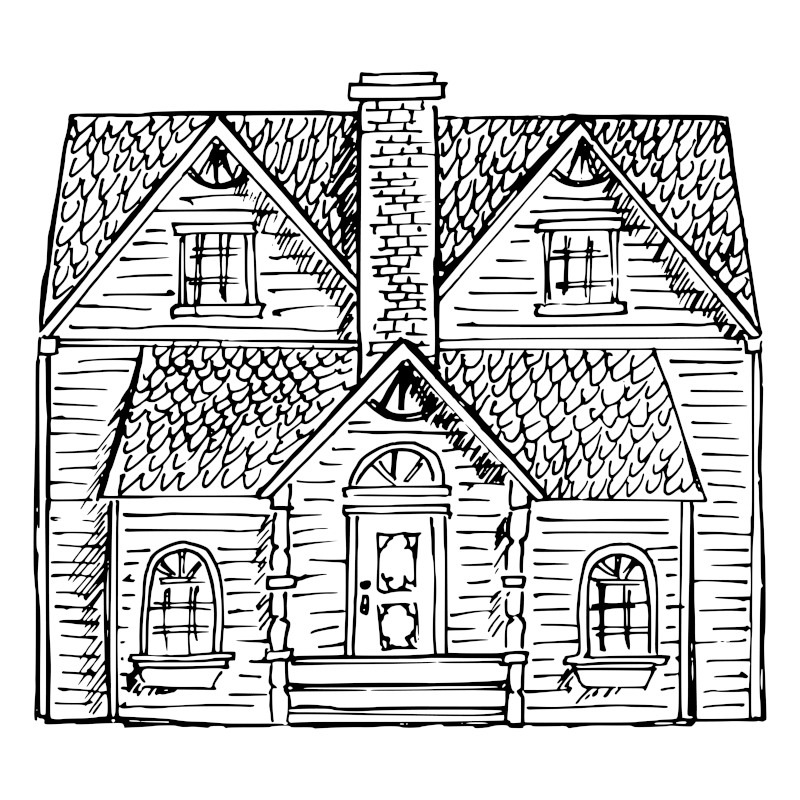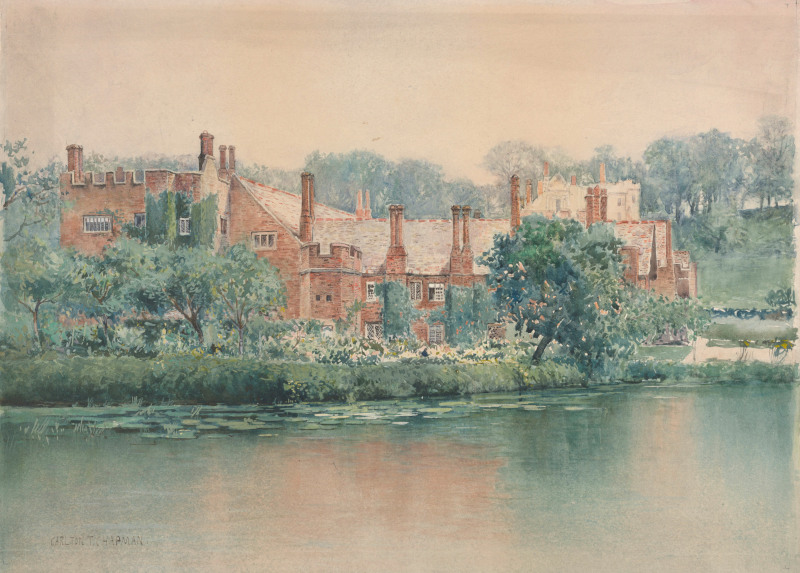Here we examine one of the earliest subjects that anyone might draw - houses. We offer a variety of ways in which to quickly sketch an easy house artwork, as well as providing much more complex paintings from the realm of art history.
Introduction to House Drawings
The simplest of house drawings can be pulled off by a child at a relatively young age, using their primitive, but highly charming two dimensional format, with which we are all familiar. It often represents how life should be, with a small family home and garden, with their family members filling each room. In this article we will provide many different ideas and sources of inspiration for drawing homes, whatever your level, along with famous oil paintings that take things a step or two further.
House art has brought us an idealised version of our lives, with examples such as the Chocolate Box Cottage, and much of this is reproduced in children's cartoons, where simplicity is necessary. These easy, simple drawings can often tell us much about how each person, and the culture in which they live, view aspirations and expectations within their life, even when the drawings are completed by young children.
List of House Drawings and Paintings
In order to flood your mind with inspiration, we have included a list of house drawings and paintings below, ranging from the simplest of sketches for those looking to teach children how to learn basic drawing techniques, to far more polished, professional art. All with have their own advantages, and potentially help you to mould your own works, with a variety of styles and compositions also featured below.
Additionally, style of architecture is also something to consider. We will all naturally make drawings of houses which match the architecture of our local area, in most cases. In some cases, we might be inspired by styles from other cultures, perhaps influenced by literature, but this would be relatively rare by comparison.
The Town (1917) woodcut art by Mildred McMillen
Here we examine black and white, through the woodcut art of the early 20th century. This complex series of houses is delivered by Mildred McMillen and offers an interesting artwork in which we can learn how to draw or paint homes from a multitude of different angles. Those looking to understand perspective and see much in this piece, and perhaps might trace individual buildings in order to practice their craft.
 woodcut art by Mildred McMillen.jpg) The Town (1917) woodcut art by Mildred McMillen
The Town (1917) woodcut art by Mildred McMillen
Simple, Easy Victorian House Drawing
This relatively simple sketch of a Victorian home is intended to give you an opportunity to learn the basics of drawing houses. Only the necessary detail is included, with this image being provided by rawpixel as a public domain image. The style of the architecture places it very much in the Victorian era, and lines are loosely applied in a manner that suggests the artist worked quickly on this piece, once the key structure had been completed. This style of drawing could today be completed on a tablet device, removing errors using software as you go.
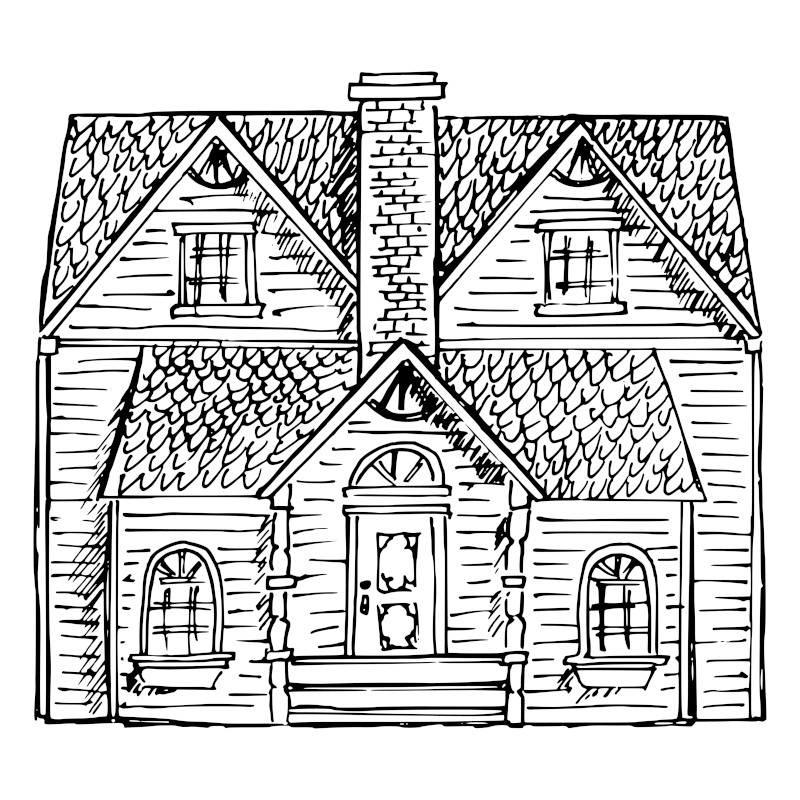 Simple, Easy Victorian House Drawing, (copyright-free public domain image courtesy of rawpixel)
Simple, Easy Victorian House Drawing, (copyright-free public domain image courtesy of rawpixel)
Colored Cartoon House with Chimneys and Door Illustration
This colored drawing is intended to look similar to how a child would first draw a home, but is clearly produced by an adult as shown in the details added around the door, and also in the way that lines are perfectly straight and proportioned correctly. This simple illustration would be a great starting point for those looking to learn how to draw a house, with just a few main details to first cover, which could be achieved by tracing the main elements. This image was also provided by rawpixel as a public domain, copyright-free image.
 Colored Cartoon House with Chimneys and Door Illustration
Colored Cartoon House with Chimneys and Door Illustration
Highly Detailed Cottage houses for village and country homes (1899) vintage illustration by S. B. Reed
 vintage illustration by S. B. Reed.jpg) Highly Detailed Cottage houses for village and country homes (1899) vintage illustration by S. B. Reed
Highly Detailed Cottage houses for village and country homes (1899) vintage illustration by S. B. Reed
Sweet Sake House at the Foot of Mt. Hakone, 6:00 p.m. on a Spring Day by Kobayashi Kiyochika
Japanese artists have used innovative methods to depict houses within their work and many European artists have learnt much by studying their art. The immediate piece below indicates how to contrast buildings against hills and mountains, and see also the use of perspective as the buildings lead off into the background. The other examples featured here show how perspective differed in art across different cultures and periods, as advancements were made, and then new styles came in which aimed to re-invent techniques. Cubism, for example, brought about new ideas with angles, before abstraction and expressionism completely changed everything once more.
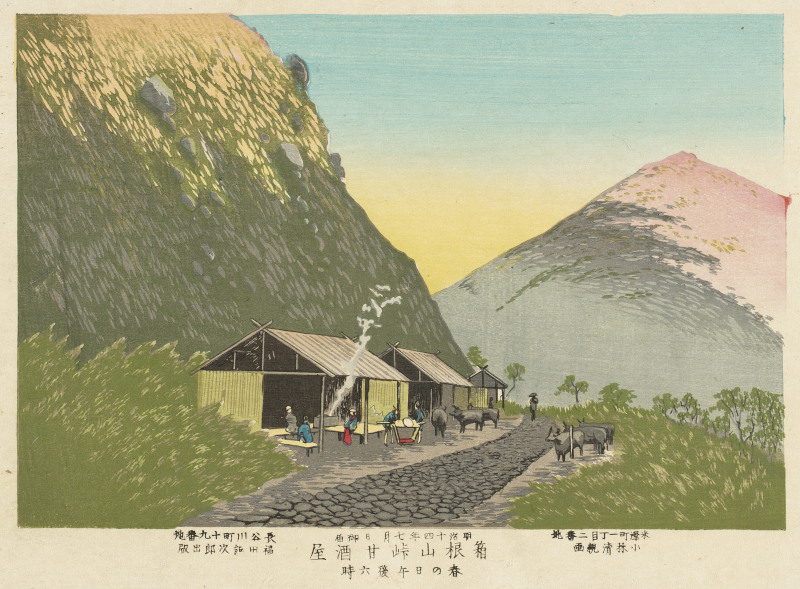 Sweet Sake House at the Foot of Mt. Hakone, 6:00 p.m. on a Spring Day by Kobayashi Kiyochika
Sweet Sake House at the Foot of Mt. Hakone, 6:00 p.m. on a Spring Day by Kobayashi Kiyochika
Minakuchi by Utagawa Hiroshige
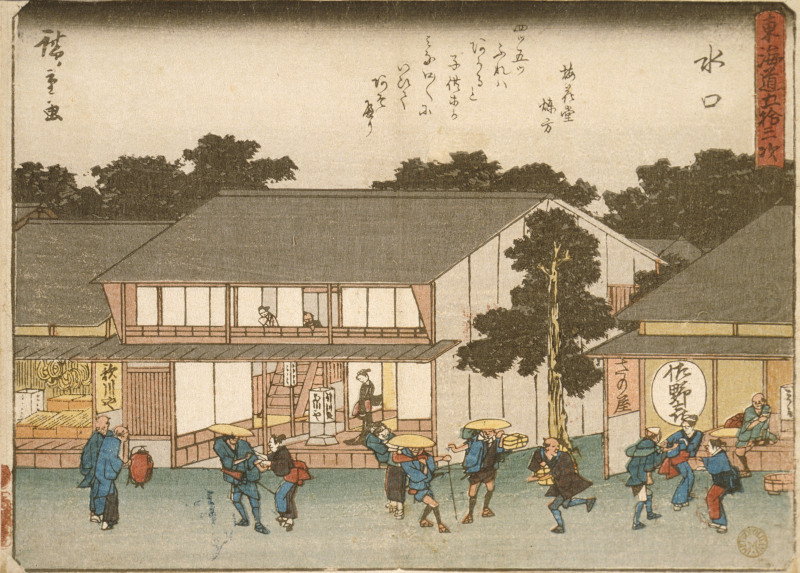 Minakuchi by Utagawa Hiroshige
Minakuchi by Utagawa Hiroshige
Snow Scene at the Shrine of Benzaiten in the Pond at Inokashira (1843), Japanese illustration by Utagawa Hiroshige
, Japanese illustration by Utagawa Hiroshige.jpg) Snow Scene at the Shrine of Benzaiten in the Pond at Inokashira (1843), Japanese illustration by Utagawa Hiroshige
Snow Scene at the Shrine of Benzaiten in the Pond at Inokashira (1843), Japanese illustration by Utagawa Hiroshige
An English Country House
Farm near Duivendrecht (1916) painting in high resolution by Piet Mondrian
 painting in high resolution by Piet Mondrian.jpg) Farm near Duivendrecht (1916) painting in high resolution by Piet Mondrian
Farm near Duivendrecht (1916) painting in high resolution by Piet Mondrian
School Time (ca.1874) by Winslow Homer
 by Winslow Homer.jpg) School Time (ca.1874) by Winslow Homer
School Time (ca.1874) by Winslow Homer
Gustav Klimt's Kirche in Cassone
Klimt regularly captures scenes of small towns and vilages across Austria, and he most enjoyed places located along rivers. Churches would be the dominant building in many of these locations at that time, and Klimt had a unique manner in how he depicted the houses and trees together. Whilst he remains more famous for classic works such as The Kiss and Tree of Life, there are many who specifically love his town scenes such as this, which really captured the beauty of this region. He was classed as an Art Nouveau artist, having become a major figure in the Vienna Secessionist movement.
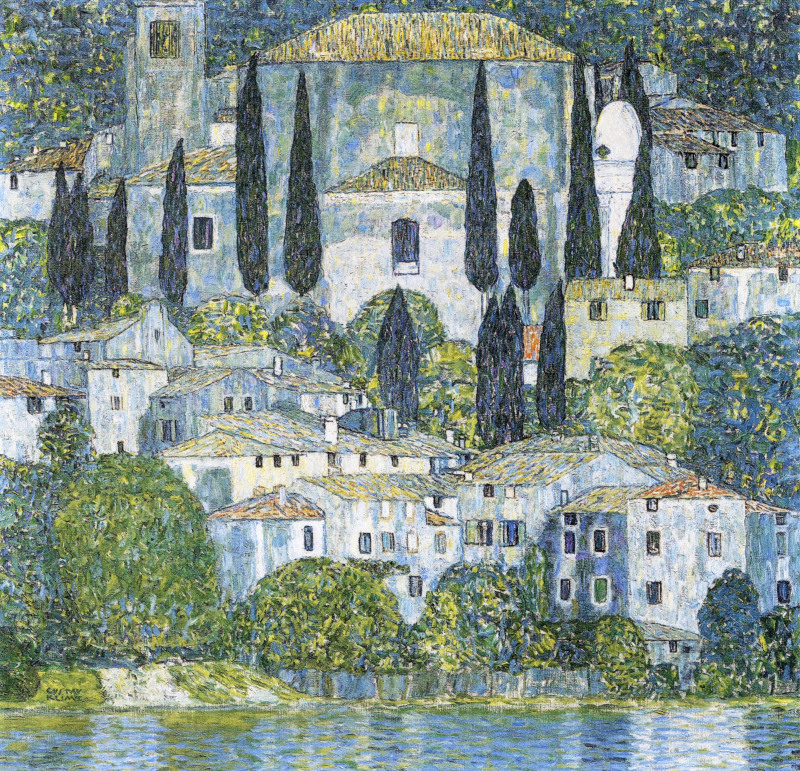 Gustav Klimt's Kirche in Cassone
Gustav Klimt's Kirche in Cassone
In the Garden (1874) by Winslow Homer
 by Winslow Homer.jpg) In the Garden (1874) by Winslow Homer
In the Garden (1874) by Winslow Homer
Environs of Briey (Environs de Briey) (1899) by Pierre-Auguste Renoir
Renoir's style produced a hazy, dream-like look to his work and he regularly featured nature across his career. In this example he focuses on a rural home and carefully plans the composition by framing the scene with nature from either side. The trees are therefore included to balance the piece, but the main focal point is intended to be the farmhouse which lurks at the back, with terracotta roofs which capture the essence of continental Europe. Green tones dominate here, just as they do with much of his work, helping to create an atmosphere of nature and tranquility.
 (1899) by Pierre-Auguste Renoir.jpg) Environs of Briey (Environs de Briey) (1899) by Pierre-Auguste Renoir
Environs of Briey (Environs de Briey) (1899) by Pierre-Auguste Renoir
Vincent van Gogh's Stairway at Auvers
This beautiful work by Van Gogh features a number of local people making their way down a countryside path which leads towards a row of houses. Greenery is shown everywhere, providing the rural setting, and the artist incorporates reddish tones to the roof which work well against the white painted walls beneath. A windy set of steps leads up to the houses, and notice how the artist allows his lines to curve creatively, with much of his work having a feeling of dreams within them.
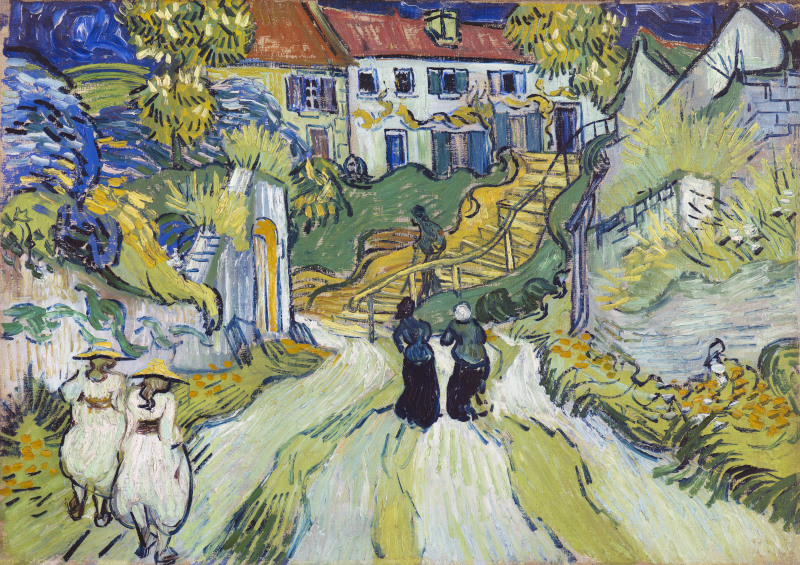 Vincent van Gogh's Stairway at Auvers
Vincent van Gogh's Stairway at Auvers
The Hunters in the Snow (Winter) by Pieter Bruegel the Elder
Hunters in the Snow by Pieter Bruegel may not be the best way of learning how to draw a house, but it is a truly charming artwork which shows how to incorporate homes into a wider landscape. In this piece the artist captures a scene during winter, and stands on a hillside, as hunters would down hill, back towards their homes in a small village. There is a feast of detail to enjoy in this masterpiece from Dutch art, with rolling hills in the foreground and background, activity in the sky with birds, and below with ice skaters, as well as further details in each and every inch of the rest of this classic work.
 by Pieter Bruegel the Elder.jpg) The Hunters in the Snow (Winter) by Pieter Bruegel the Elder
The Hunters in the Snow (Winter) by Pieter Bruegel the Elder
Choosing Your Drawing Materials
It is worth taking some time to prepare the right drawing materials, prior to starting your first drawing. Depending on your own preferences, you might seek to produce a drawing from pens, pencils or even marker pens. Alternatively, watercolors, acrylics and colored pencils can give a painted finish instead. Oils are harder to use, and not advisable for artist beginners, but offer many benefits that you might consider in the future, including bold tones of color.
There are also different materials that you might use to put your artwork on. Single paper pages can be easy to acquire and use, whilst others might prefer sketchbooks, in which multiple artworks can be kept together - they are also great for travelling around. Finally, digital art allows us to sketch on tablet or mobile devices, and whilst there is not the fun of playing with physical elements in the application, these can still be beneficial in understanding the basics of drawing.
Starting with Basic Shapes
It forming an easy sketch of a house, it is best to start with the outline of the building, and then slowly add detail. For children's sketches, normally they will construct the house using a simple rectangle, and then start to use circles and squares for doors, windows and other features. Chimneys are also popular, even though most modern homes will not have one - this is one of the many items left over from historical children's stories that still influence us today, even as architecture continues to evolve.
Once the child understands this method, they can then repeat the process multiple times, slowly improving the accuracy of their work. Things can be levelled up, and windows and doors can be adjusted to be sized more correctly. Once they are happy with their work, then you can move on to other details in this artwork, such as garden elements, sky scenes and even portrait figures.
Step-by-Step House Drawing Tutorial
The best step-by-step guide for drawing a house would be to start by adding the outline of the house itself. Follow this with the roof structure, followed by key elements such as the doors, windows, chimneys and then smaller details within each of them. Next you will apply the landscape and any elements of the sky, before proceeding to evolve these items with more detail, where appropriate. At each stage it is worth sitting back and reviewing your progress in case you have gone off course, as it may not be possible to spot this if you are only focusing on one area of the artwork individually.
Tips for Beginners and Kids
Regular practice and learning from mistakes are the best methods for youngsters to learn how to draw, and these principles should also benefit amateur artists of any age. Observation, and the ability to break down elements into simpler component parts are also important techniques to master as you evolve as an artist. OVer time you can try out different mediums, but it is advisable to keep things simple early on, as you build your confidence. Using referenced images, such as from photographs or existing art also helps avoiding having to learn everything immediatly, and over time you can learn to work from your own mind instead.
Adding Depth and Dimension
As one's drawing skills develop, it may be advisable to learn skills related to depth, perspective and dimension. These abilities can help to lift the quality of your work, and bring more variety into your art. It is not interesting to continally handle buildings from the traditional, front-on view, when so many other angles can be used. One can even alter their own position in relation to the building for different effects, such as standing from a hill and looking downwards. Photographers may help to give you different ideas in this regard. It is also worth experimenting with the relationship in size between different objetcs, creating unusual displays of perspective.
Bringing Your Drawing to Life with Color
Color has a massive impact in art, and a careful choice can bring great benefits to your work. For example, you might want to present a warm or cold atmosphere, depending on the seasons at the time. Certain colors can complement or clash with each other, as shown by the Fauvists and other 20th century artists and so you must consider your wider palette as a whole. Also, in different cultures, different colors will be used in architecture and so one should remain broadly faithful to the original choices if we are seeking accuracy.
Creating Texture and Details
For those who have mastered the basic details, you might want to start to add texture and finer details to your work. This may be more relevant to house painting, rather than drawing. Textures can be created by scratching into the existing paint, helping to reveal any layers below. A palette knife can also be great for layering up the paint, creating a thickness which the viewer will notice, even after the paint has dried - lovers of Vincent van Gogh will have noticed this in many of his paintings. Additionally, artists always have to find the right balance between realism, abstraction and expression, and much will depend on their own personal taste.
Painting a Simple House Landscape
When putting together a house within a landscape, it is worth loosely planning out the details that you want to add, prior to starting the drawing. Once you have finished the house itself, you can then add elements close to the house itself, such as garden features. Then in the distance, try out some elements to bring perspective, such as some trees in the distance, maybe even a flowing river, or a mountain range. Finally, put together the sky with a series of clouds, the sun itself, and perhaps even some birds flying past by, depending on the type of atmosphere that you desire.
Correcting Mistakes and Improving Your Work
There are many simple ideas that will help you to improve your technical work over time. Firstly, taking a break during the process, particularly when you get stuck, is a great way of refreshing the mind and also finding an alternative perspective which might help your working process. Additionally, when mistakes are made it is best to learn from them, and see how you might do better next time. By repeating this process, your level of accuracy will quickly improve.
Depending on the types of materials that you use, it may be possible to quickly correct errors, by erasing them out. This is the case with pencils, where as with other mediums it will be much more difficult, such as with the use of oils or watercolors. With digital art software, those drawing by tablet, can remove their last step very easily, and this makes this a good tool for beginners. Patience and persistence are crucial to long term success, and it might be wise to cosult others for constructive criticism for ideas on how to evolve your work.
Inspiration from Real Houses and Art
Inspiration for your work can be drawn from all manner of different sources. Architectural magazines, as well as home buying publications can bring different styles of homes to your attention. Travel guides can also bring exotic ideas to mind as well. Modern and vintage photography can be a further source of inspiration, but the best option will always be from visiting their constructions in person. Sketchers can sit and draw in peace, though if there are residents at home, it might be worth explaining what you are doing first!
Listicles, articles of lists, can bring many good ideas together with titles such as best new buildings, or best vintage architecture within a specific region. There is a wealth of visual tooks out there to take advantage of, and you might also consider taking photographs of your own, for those who prefer to sketch from the comfort of their own homw.
Framing, Displaying and Sharing Your Artwork
Once your artwork is finished, if you are happy with it, you might consider framing it and hanging it in your own home. Many grandparents, for example, love to proudly show off early drawings by their grand children, and fridges have often been used for displaying these early artworks, held on by a random combination of carefully placed fridge magnets. For the braver amongst you, sharing online is another options for quickly gathering opinions on your work, but be careful who you ask for comment, as the online world can be somewhat brutal at times.
Conclusion: Embrace the Joy of Simple House Art
Art is about creativity and expression as much as it is about re-producing a lifelike image. For children, drawing a house can be their very first experience of art, and enjoyment is the most important factor at this point. Much can be gained by the simple activity, as it has many mental health benefits, even before you start to improve your skills. The focus on simplicity can also help us to break elements down into their parts, creating an understanding of how something is formed.
Another potential benefit from house art, or any other early artistic outlet, is in how it can bring people together - even children struggling to learn to talk can communicate by adding their friends and family to a portrait, or indicating what sort of things they like. As they grow older, so their skills can develop and it can also help them to build strength in their wrists and hands, which could benefit their handwriting too.



